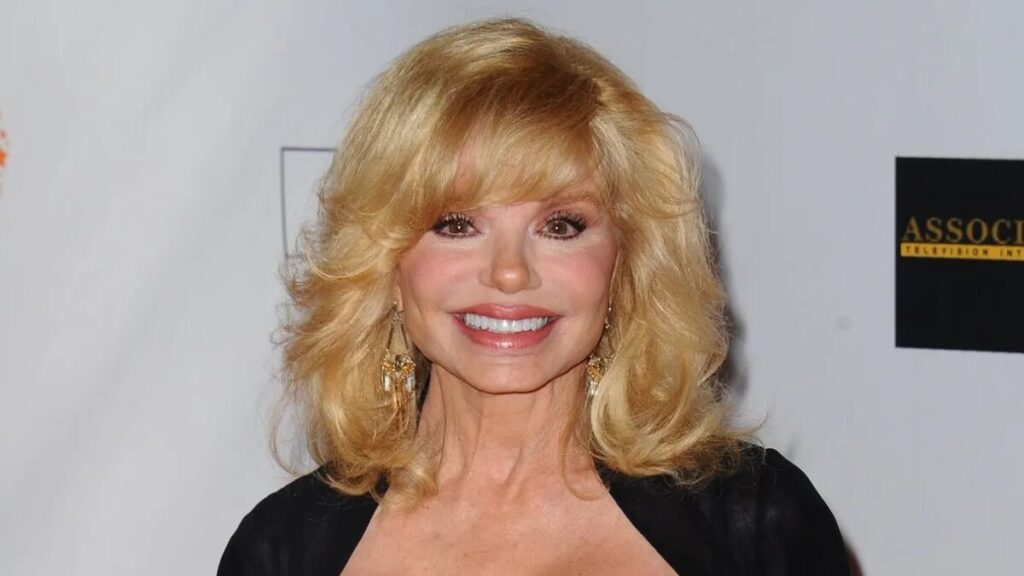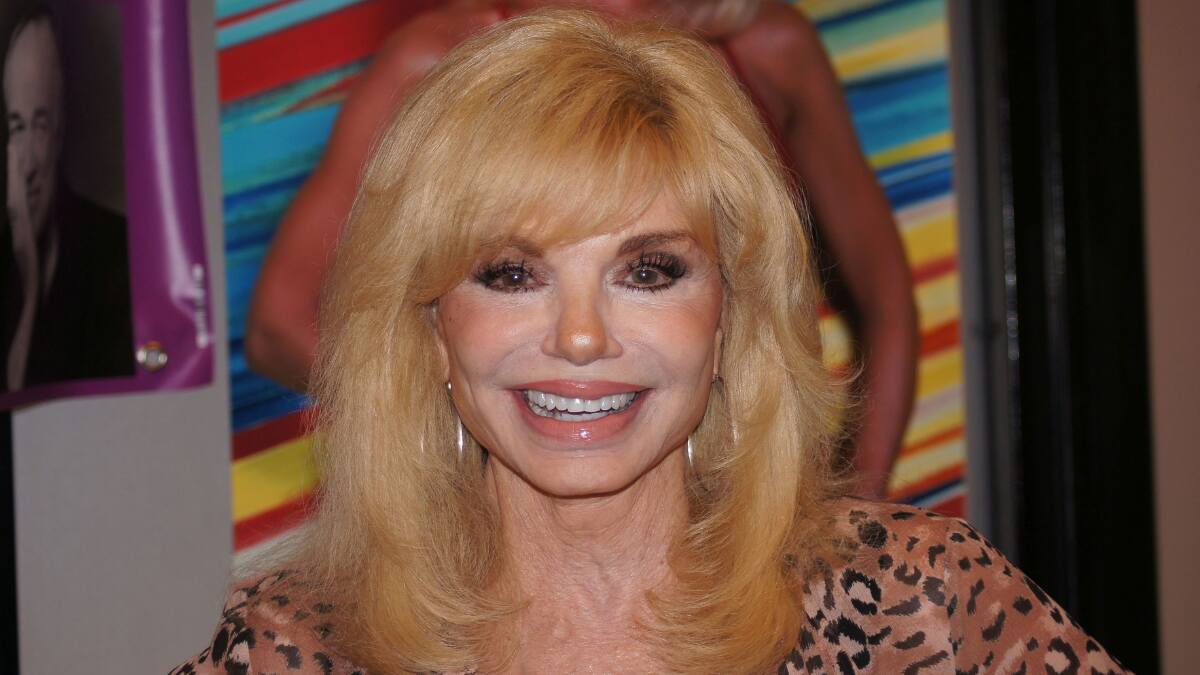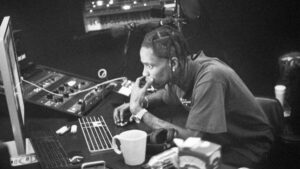In the late 1970s, few television characters lit up the screen quite like Jennifer Marlowe. With her honey-blonde hair, tailored suits, and a smile that could stop a newsroom cold, Loni Anderson became the poster woman for sitcom seduction — the quintessential “blonde bombshell.” Magazine covers came calling. Tabloids followed her love life like a soap opera. To millions, she wasn’t just acting glamorous — she was glamour.
But beyond the flashbulbs and feathered hair was a woman navigating a far more complex terrain. Loni wasn’t handed her career on a silver studio tray — she carved it out, role by role, often in the face of reductive casting and deeply rooted industry bias. While the world was busy admiring the surface, Anderson was busy mastering her craft, asserting her voice, and — quietly — outsmarting a system that rarely took women like her seriously.
This isn’t a retelling of fame or scandal. It’s a deeper look into the studio years that shaped her — the moments most people never saw, and the stories rarely told. Beyond the blonde stereotype lies a career built on persistence, instinct, and unshakable wit. And it’s time we gave that version of Loni Anderson a proper spotlight.
Before WKRP: The Hustle of a Minnesota Girl in a Studio System World
Loni Anderson didn’t arrive in Hollywood trailing glitter — she arrived with a theater degree from the University of Minnesota, a single mother’s grit, and the kind of beauty that made casting agents do double takes. But while her looks opened doors, they also built barriers. “Too pretty for the role” became a frequent refrain, a backhanded compliment that haunted her earliest auditions. She wasn’t looking to be decorative. She wanted to work.
In the late 1960s and early ‘70s, the studio system was still clinging to its old, male-dominated playbook, where actresses were expected to be pliable, ornamental, and grateful. For Loni — raised on Midwestern pragmatism and stagecraft — this culture clash was immediate and unnerving. She landed small parts on shows like S.W.A.T., Police Woman, and The Love Boat, but most of her days were spent hustling: in cattle-call auditions, cold readings, and backlots that often treated women like walking set pieces.
Her early days were marked by near-misses. She famously auditioned for a role on Three’s Company and lost out, reportedly, because she was “too smart-looking” to play the ditzy blonde. That backhanded praise followed her everywhere — she didn’t fit the dumb blonde mold, and the industry wasn’t quite sure what to do with that.
To pay the bills, she modeled, voiced commercials, and took thankless walk-on roles that paid just enough to keep her going. Yet, by all accounts, she never played the victim. She studied. She refined her timing. And she waited — not passively, but strategically — for the role that would let her prove there was more to her than the bone structure and bombshell styling.
By the time WKRP in Cincinnati came calling in 1978, Loni Anderson wasn’t an overnight success. She was a seasoned survivor of Hollywood’s unwritten rules — and finally, she’d found a way to rewrite them.
“She Wasn’t Just Hair and Hips”: Producers on Loni’s Comic Chops
Loni Anderson didn’t need a laugh track. Her comedy lived in the pause — a perfectly timed eyebrow raise, a sly glance to the camera, a deadpan line delivered with surgical precision. For all the glitz she brought to WKRP in Cincinnati, what truly set her apart was a talent that left even seasoned producers stunned: her innate sense of comic rhythm.
“People assumed we cast her for her looks,” series creator Hugh Wilson once said, “but by the end of the first week, we all realized she had the sharpest instincts in the room.” Anderson’s character, Jennifer Marlowe, could’ve easily been a one-note blonde joke — the secretary with a Rolodex of wealthy admirers. Instead, she became the show’s quiet moral center, delivering punchlines with the elegance of Katharine Hepburn and the bite of Lucille Ball.
Critics at the time began to notice. TV Guide praised her as “a revelation in restraint,” noting how she resisted the temptation to overplay moments, instead letting subtle gestures land the joke. In one oft-overlooked scene, when a colleague tries to impress her with awkward bravado, Anderson responds with nothing more than a blink and a tilt of the head — and still gets the laugh.
Even her co-stars were quick to defer. “She had the toughest role,” said castmate Tim Reid, “because she had to be the beautiful one and the smartest one. That’s hard to write, and even harder to play. But she nailed it every time.”
Her comedy wasn’t broad or brash. It was patient. Self-assured. A masterclass in letting the moment breathe. It’s no coincidence that the writers began crafting smarter lines and bigger beats for Jennifer as the series went on — they had an actress who could handle nuance, timing, and wit all at once.
Loni Anderson wasn’t just a comic foil in a sitcom ensemble. She was the sharpest tool in the writers’ kit — and they knew it.
On-Set Stories You Haven’t Heard (And Can’t Google)
Behind the studio lights and tightly written scripts of WKRP in Cincinnati was a Loni Anderson most people never saw — fiercely prepared, unfailingly kind, and quietly unafraid to push back when something didn’t sit right. While the tabloids feasted on her high-profile romance with Burt Reynolds, the crew saw a different narrative unfold: one of a professional actress who treated everyone on set — from grips to guest stars — with genuine respect.
One former costume designer, who worked with Anderson across multiple episodes, recalled her as “meticulous but never difficult.” “She had an eye for detail,” they said, “especially with wardrobe — not for vanity, but for the character. She understood Jennifer wasn’t just sexy — she was powerful, elegant, and always in control. Loni helped build that image thread by thread.”
On a shoot for the show’s third season, when a script included a scene that played too closely into dumb-blonde tropes, Anderson reportedly went to the writers and calmly asked them to reconsider. She didn’t storm off or threaten to walk — she simply pointed out that the joke came at the expense of everything they’d built around Jennifer’s intelligence. The script was changed by morning.
“I Saw Loni Hold Her Ground” — A Camera Operator Remembers
“She wasn’t loud about it, but you knew when she drew a line,” recalled a longtime camera operator from the CBS lot. “There was this one day — we were shooting late, everyone was tired. A guest director made a crack about her being ‘the eye candy.’ Loni didn’t miss a beat. She smiled, said, ‘If you want candy, there’s a vending machine down the hall,’ and walked off set. Not in a huff — just enough to remind everyone that she knew her worth. Nobody ever said anything like that again.”
She brought that same energy to table reads, often suggesting quieter, smarter edits to her lines — not for ego, but because she wanted Jennifer Marlowe to be more than a punchline in a pencil skirt. Writers noticed. So did producers. Over time, the show’s tone subtly shifted, giving Anderson more space to work in nuance, dignity, and bite.
These aren’t stories meant to mythologize her — they simply reveal what’s often missed in the flash of syndication fame: Loni Anderson was nobody’s accessory. She was the architect of her legacy, one quiet rewrite at a time.
Fame, Control, and Studio Politics: Navigating Sex Symbol Status
Loni Anderson never asked to be a sex symbol — the label was assigned, broadcast, and relentlessly recycled. By the early 1980s, her image was everywhere: gracing the covers of People, TV Guide, and countless tabloids, her silhouette often more recognizable than her dialogue. Yet beneath the feathered hair and flawless styling was a woman negotiating — often quietly, but firmly — for creative control in a business that preferred her ornamental.
She understood the value of her image, but she refused to let it define the boundaries of her work. In multiple interviews, Anderson recounted turning down scripts that cast her as the ditzy blonde — even after WKRP proved she could deliver those lines with layered precision. “They kept sending me versions of Jennifer,” she told The Washington Post in 1983, “but without the intelligence. I said no a lot more than I said yes.”
One of her most public power plays came not in the form of a scandal or feud, but in contract negotiations. When WKRP became a hit, she pushed for higher pay equal to her male co-stars — a then-uncommon move that triggered studio resistance. But Anderson stood her ground, eventually securing a raise that signaled, even if quietly, that she wasn’t afraid to challenge the system.
Still, the headlines rarely told that story. While the media fawned over her “perfect 10” looks, Anderson was at press junkets steering the conversation back to craft. At photoshoots for People and Us Weekly, she’d deliver the expected glamor — then use the interviews to advocate for smarter roles and push back on typecasting.
She didn’t shun the image. She managed it — like a strategist navigating a boardroom in sequins. The result was a career that walked the narrow line between marketability and agency, proving that femininity and power weren’t mutually exclusive — they just required a woman willing to challenge the script.
The “Anderson Effect”: How She Stood Apart from Her Peers
In the glitter-drenched landscape of 1970s and early ‘80s Hollywood, a wave of blonde stardom washed across American screens — bold, camera-ready, and undeniably photogenic. Loni Anderson was often grouped with the era’s reigning icons: Farrah Fawcett, Suzanne Somers, Goldie Hawn. But within the orbit of this blonde constellation, Anderson carved out a path that was less flash, more finesse.
Where Fawcett leaned toward dramatic reinvention and Somers embraced self-branded entrepreneurship, Anderson quietly mastered the slow burn of sitcom intelligence. She wasn’t the loudest or the most rebellious — but she might have been the sharpest strategist.
| Actress | Breakout Role | Comedic Reputation | Public Persona | Post-Fame Arc |
| Loni Anderson | WKRP in Cincinnati | Witty, precise, understated | Glamorous but grounded | Steady TV work, advocacy |
| Farrah Fawcett | Charlie’s Angels | Not comedic; leaned into drama | Tragic, ethereal beauty | Bold film turns, art projects |
| Suzanne Somers | Three’s Company | Broad, physical comedy | Bubbly, controversial | Business mogul, wellness guru |
| Goldie Hawn | Laugh-In, films | Sharp, quirky, satirical | America’s sweetheart with bite | Major film career, producer |
What distinguished Anderson wasn’t just what she did, but how she did it. Unlike her peers, who often burst into fame and then pivoted quickly, Anderson played the long game. She refined a niche that mixed poise with punchlines, elegance with comic timing. Critics often noted her restraint — a quality rarely celebrated in an era of high-decibel comedy.
“She had a stillness that pulled focus,” one CBS producer noted. “While others went big, she went exact. And it worked.”
Anderson’s brand wasn’t built on shock value or reinvention, but on consistency — knowing her type and then elevating it beyond cliché. She didn’t reinvent the wheel; she sharpened it. In an industry eager to categorize and discard, that kind of self-possession wasn’t just rare — it was revolutionary.
Reinvention and Resolve: Life After the Spotlight Shifted
When the floodlights of network television began to dim, Loni Anderson didn’t fade — she simply redirected the spotlight. Rather than chase roles that no longer fit, she evolved, choosing parts that reflected her age, voice, and values. From recurring TV appearances on Nurses, Sabrina the Teenage Witch, and Baby Daddy, to voicing animated characters with self-aware charm, Anderson embraced a new era on her terms.

But perhaps her most defining work came off-screen. In 2009, she stepped forward as a spokesperson for COPD awareness — a cause deeply personal to her after her parents’ battles with the illness. She didn’t just lend her face to the campaign; she used her platform to educate, speak candidly in interviews, and encourage early diagnosis. It was advocacy rooted in experience, not PR.
In her memoir My Life in High Heels, Anderson reflected on fame, heartbreak, and reinvention with a tone that was equal parts sharp and self-effacing. She wrote not to settle scores, but to share lessons — about boundaries, grace, and survival in an industry built for youth.
“I never wanted to disappear — I just wanted to stop being something I wasn’t anymore.”
— Loni Anderson, My Life in High Heels
Family life also became a central chapter. As a mother and later grandmother, Anderson often spoke about finding a different kind of fulfillment — one untethered from applause.
Her resilience wasn’t flashy. It was measured, thoughtful, and deeply human. In an industry that often discards its leading ladies after 40, Loni Anderson proved that reinvention wasn’t just possible — it could be purposeful, powerful, and done with lipstick still intact.
Why Her Story Still Matters (Especially Now)
Loni Anderson’s story isn’t just a footnote in television history — it’s a lens through which we can trace the slow, stubborn evolution of Hollywood’s treatment of women. Long before “feminism” became a marketable buzzword in the industry, Anderson was challenging reductive roles, negotiating for equal pay, and reshaping what it meant to be a “blonde bombshell” on her terms.
In today’s ongoing conversations about ageism, typecasting, and the pressures placed on women to balance beauty with credibility, her career feels startlingly relevant. She played the game, yes — but she also rewrote parts of the rulebook while the cameras rolled.
More importantly, her story reminds us that ambition doesn’t have to be loud to be powerful. Anderson’s battles weren’t always public, but they were purposeful. She carved out space for women to be glamorous and grounded, funny and fierce — long before the culture had the vocabulary to celebrate that duality.
As the industry continues to reckon with who gets to be seen and heard, Loni Anderson’s legacy stands as proof that you can be more than the mold you’re cast in — and still steal the spotlight on your terms.
Nishant Wagh is the founder of The Graval and a seasoned SEO and content strategist with over 15 years of experience. He writes with a focus on digital influence, authority, and long-term search visibility.





4 thoughts on “Beyond the Blonde Bombshell: Rare Stories from Loni Anderson’s Studio Years”